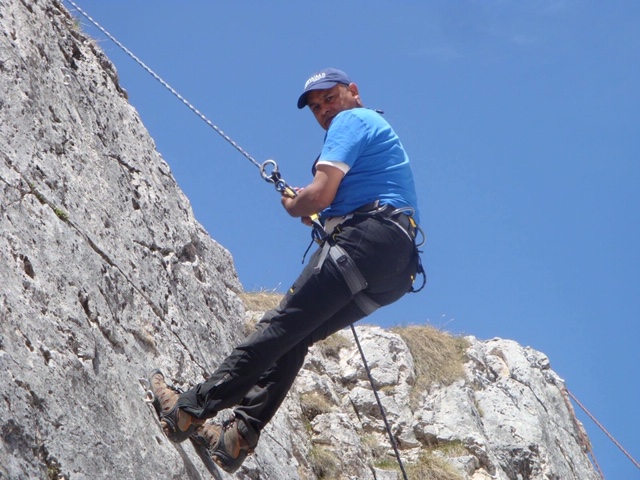The light is gone

Prakash in Nepali means light. And in his 54 years of life, Prakash Adhikari was a beacon of light -- helping save the lives of countless trekkers, porters and pilgrims across the Himalaya.
He headed the Himalayan Rescue Association (HRA) which operates clinics for trekkers and their guides and porters in the main trekking route below Mt Everest and the Annapurna Circuit. He died in Kathmandu on 23 October due to Covid-19 pneumonia.
At HRA, Adhikari went out of his way to help sick and stranded porters accompanying trekking and mountaineering groups who could not afford to be air lifted out after suffering from acute mountain sickness, or other ailments.
Adhikari showed that you did not have to be a rich person to help those in need -- all you required was humanity and compassion. Helping others, especially the vulnerable and disenfranchised, gave him energy. And he was not the type to boast about his generosity of spirit.

He skillfully negotiated with helicopter pilots who were in the Khumbu ferrying trekkers and climbers, to also fly out sick porters. Insurance paid for the medevac of foreigners, but Adhikari would convince the pilot to also take porters down to lower altitude. This simple act saved many lives because severe altitude illness often responds to just rapid descent.
And, as though this were not enough, if the sick porter was brought to expensive Kathmandu with no one to help (porters in the Khumbu are usually from the lower valleys of eastern Nepal) Prakash took it upon himself to receive the porter at the airport, take him to a hospital and follow up -- all the time wondering where on earth he would help find the money to pay for the porter’s hospital bills. Somehow, miraculously, financial help would always turn up.
He also made sure that trekkers and tourists on the Everest trail were all treated well because he clearly realised that by doing so he would be helping everyone, especially the tourism sector, so vital for Nepal’s economy. His small contribution, he felt, would help alleviate poverty among Nepalis who depended on tourism income, a topic that often devastated him for his ability to do so little in this regard.
His close attention to safety in the mountains was not limited to foreign tourism. For almost 25 years he dedicated himself through the HRA to organising the yearly Gosainkunda health camp at 4,300 m so that thousands of pilgrims could ascend safely from Dhunche (2,000m) with emphasis on prevention and treatment of altitude illness.

Prakash also contributed to academic mountain medicine by actively helping many young Nepali and Western doctors to cut their professional teeth on altitude medicine with proper supervision by senior experienced doctors on these high-altitude camps. He even encouraged medical research to find out more about the vulnerability of Nepal’s pilgrim population.
As the CEO of the HRA, he helped high altitude doctors to highlight the plight of the pilgrims. He even actively helped out with determining that lower dose of Diamox (125 mg twice a day) with fewer side effects was good enough for the prevention of acute mountain sickness, unlike what a British Medical Journal’s meta-analysis had earlier reported.
Although us doctors at the HRA planned and conducted this high altitude research, none of it would have been possible in Nepal’s bureaucratic setup without his strong backing and gentle encouragement.
The bureaucracy also involved obtaining official approvals from the Ministry of Health, Labour Ministry and Immigration Department in Kathmandu for volunteer HRA doctors for its aid posts in Manang (3,519m), Pheriche (4,300m) and Everest Base Camp (5,600m).
He first collected all the certificates from the volunteer doctors, had these vetted by us health professionals at the HRA and then started his rounds (with the generous and necessary help of other HRA officials) of the ministries and approval boards. His caring, friendly nature and diplomatic skills clearly came in handy as he navigated these corridors of power to seek approvals.
I have no idea where he obtained this relentless strength to do these rounds twice a year especially when officials in the ministries changed so frequently. But his immense sense of humour and positive attitude helped.
Prakash got a very modest salary at the HRA, it was almost a voluntary job. Yet, every day he dealt with Nepali trekking agents who easily earned many times what he was paid. He could easily have jumped ship for better pastures, but Prakash was so focused on his work that he did not let this financial disparity get in the way.

Courteous and honest to a fault, he was also practical, not allowing any financial bitterness and frustration to overshadow his calling. Prakash was a model citizen, the back-bone of HRA, and a truly unsung hero. All of us Nepalis, foreigners, porters, pilgrims owe him a debt of gratitude, and will miss him greatly.
This holiday season of Dasain and Tihar would have been the busiest time at the HRA, with clinics having to be staffed, and rescues carried out. Ironically, the same disease that claimed Prakash’s life this week also devastated Nepal’s trekking season in 2020.
Prakash never took leave at Dasain and Tihar, he was always on call. But amazingly, despite this busy life, he also obviously took very loving care of his family. His son Binamra is so inspired by the help his father provides in the mountains that he also joined medical school. Prakash was overjoyed.
For all the contributions that Prakash Adhikari made to tourism in Nepal, the government should bestow him the highest posthumous honour. There is probably no one who, with zero financial incentive, has done so much with so little to promote safe trekking and climbing in the Nepal Himalayas over the last 25 years.
Buddha Basnyat MD is the Medical Director for the Himalayan Rescue Association and contributes the health column, Dhanvantari for Nepali Times.




